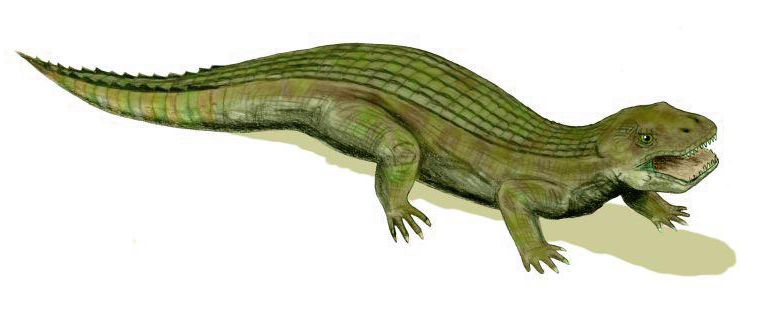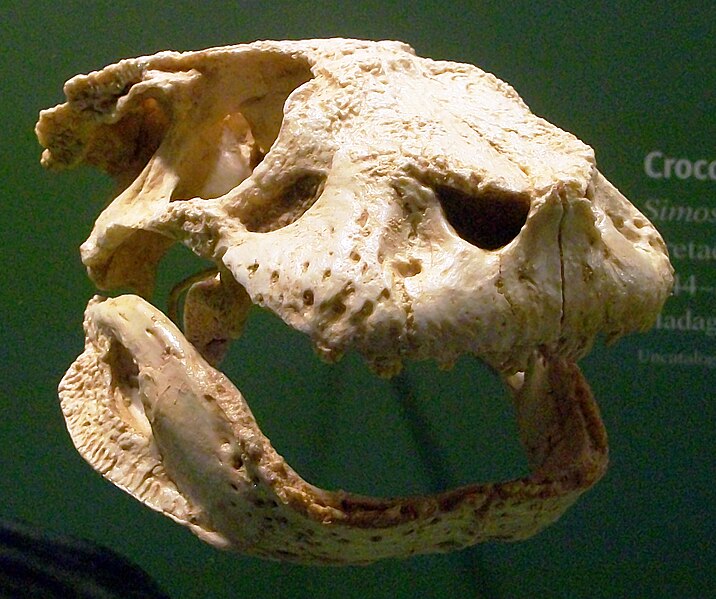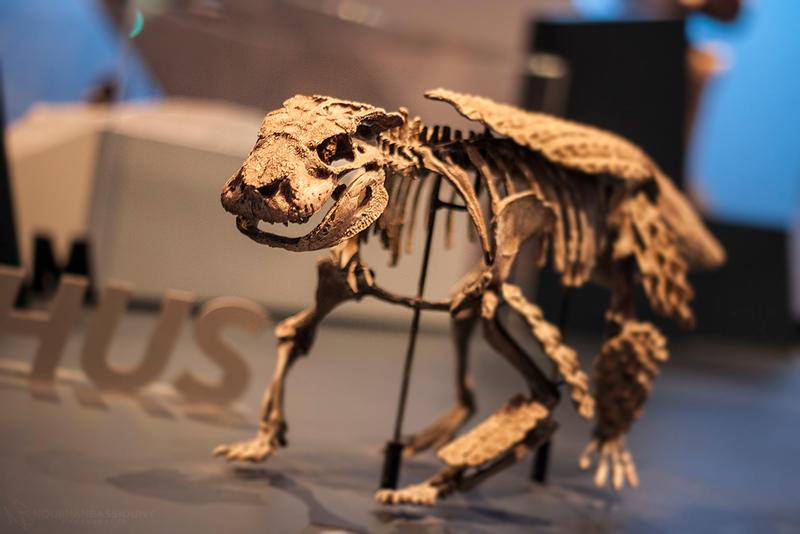[Recent Entries][Archive][Friends][User Info]
March 26th, 2014
| March 26th, 2014 | |
|---|---|
| 10:09 am [industrialterro] [Link] |
Pissarrachampsa Pissarrachampsa (meaning "piçarra [the local name for the sandstones it was recovered from] crocodile") is an extinct genus of baurusuchid mesoeucrocodylian from the Late Cretaceous of Brazil. It is based on a nearly complete skull and a referred partial skull and lower jaw from the Campanian - Maastrichtian-age Vale do Rio do Peixe Formation of the Bauru Group, found in the vicinity of Gurinhatã, Brazil. Pissarrachampsa is known from a nearly complete holotype skull with the tip of the snout eroded away. The end of the snout and the bottom of the palate are also represented by a second fossil. Like other baurusuchids, it has a deep skull that narrow in front of the eyes and wider at the back, giving it a roughly triangular shape when viewed from above. The snout is not as narrow as other related baurusuchids, however. At around 70% the length of the entire skull, the snout is also short in comparison to those of other crocodyliforms. Like other baurusuchids, Pissarrachampsa has an enlarged caniniform tooth in the upper jaw. Including the enlarged caniniform, there are four teeth implanted in the maxilla, less than other baurusuchids. A groove extends behind the last of the maxillary teeth. While other baurusuchids have more teeth implanted this groove, Pissarrachampsa likely lost these teeth, giving it a reduced dentition. A deep notch between the maxillae and premaxillae provides room for an enlarged fourth dentary tooth in the lower jaw when the mouth is closed. Another large dentary tooth fits into a hole at the back of the upper jaw. Except for the fourth dentary tooth, no teeth in the lower jaw are visible when the mouth is closed. The nostrils are positioned at the tip of the snout and face forward. They are found in a depressed region called the circumnarial fossa. Thick palpebral bones overly the eyes. The supratemporal fenestrae, two large holes on the skull roof, are almost the same size as the eye sockets and are roughly triangular in shape. The thick anterior and medial rims of the supratemporal fenestrae are a diagnostic feature of Pissarrachampsa. At the back of the skull are four quadrate fenestrae, small depressions that Pissarrachampsa shares with other notosuchians. In Pissarrachampsa, these fenestrae are visible when the skull is viewed from the side, but in other baurusuchids, they are hidden within a deep notch in the back of the skull. The pterygoid wings extend down from the bottom of the skull as two large triangular pieces of bone. A deep depression on each wing serves as another diagnostic characteristic of the genus. Another unique feature can be found underneath the back of the skull; four holes called Eustachian foramina provide an opening for the Eustachian tubes, and in Pissarrachampsa the outer or lateral pair are larger than the inner or medial pair. Интересную находку удалось обнаружить простому муниципальному служащему из маленького городка в одном из бразильских штатов Минас-Жерайс еще в 2008 году. Ранее этой находкой никто не интересовался. Но недавно об этом узнали палеонтологи из Университета Сан-Паулу и канадского Университета Макгилла. После сравнения Pissarrachampsa sera с другими баурузухиями, палеонтологи обнаружили большие отличия в строении нового вида. "Мы имеем дело с исключительно далеко расходящимися линиями крокодиловых. Предстоит найти еще много окаменелостей, чтобы связать этого крокодиломорфа с его предшественниками и потомками в процессе эволюции”, – убежден один из авторов исследования Фелипе Монтефельтро (Felipe Montefeltro). Tags: Вымершие рептилии, Мел, архозавроморфы, архозавры, баурузухиды, диапсиды, зифозухии, крокодиломорфы, круротарзы, мезоэукрокодилии, нотозухии, равизухии, себекозухии |
| Time | Event |
| 10:41 am [industrialterro] [Link] |
Simosuchus Simosuchus (meaning "pug-nosed crocodile" in Greek, referring to the animal's blunt snout) is an extinct genus of notosuchian crocodylomorphs from the Late Cretaceous of Madagascar. It is named for its unusually short skull. Fully grown individuals were about 0.75 metres (2.5 ft) in length. The type species is Simosuchis clarki, found from the Maevarano Formation in Mahajanga Province. The teeth of S. clarki were shaped like cloves (maple leaves), which coupled with its short and deep snout suggest it was not a carnivore like most other crocodylomorphs. In fact, these features have led many palaeontologists to consider it an herbivore. Simosuchus was small, about 0.75 metres (2.5 ft) long based on the skeletons of mature individuals. In contrast to most other crocodyliforms, which have long, low skulls, Simosuchus has a distinctively short snout. The snout resembles that of a pug, giving the genus its name, which means "pug-nosed crocodile" in Greek. The shape of skulls differs considerably between specimens, with variation in ornamentation and bony projections. These differences may be indications of sexual dimorphism. The front portion of the skull, or preorbital area, is angled downwards. Simosuchus likely held its head so that the preorbital area was angled about 45° from horizontal. The teeth line the front of the jaws and are clove-shaped. At the back of the skull, the occipital condyle (which articulates with the neck vertebrae) is downturned. 45 autapomorphies, or features unique to Simosuchus, can be found in the skull alone. In most respects, the postcranial skeleton of Simosuchus resembles that of other terrestrial crocodyliforms. There are several differences, however, that have been used to distinguish it from related forms. The scapula is broad and tripartite (three-pronged). On its surface, there is a laterally directed prominence. The deltopectoral crest, a crest on the upper end of the humerus, is small. The glenohumeral condyle of the humerus, which connects to the pectoral girdle in the shoulder joint, has a distinctive rounded ellipsoid shape. The limbs are robust. The radius and ulna of the forearm fit tightly together. The front feet are small with large claws, and the back feet are also reduced in size. There is a small crest along the anterior edge of the femur. On the pelvis, the anterior process of the ischium is spur-like. Most of the spinal column of Simosuchus is known. There are eight cervical vertebrae in the neck, at least fifteen dorsal vertebrae in the back, two sacral vertebrae at the hip, and no more than twenty caudal vertebrae in the tail. The number of vertebrae in the tail is less than that of most crocodyliforms, giving Simosuchus a very short tail. Like other crocodyliforms, Simosuchus was covered in bony plates called osteoderms. These form shields over the back, underside, and tail. Unusually among crocodyliforms, Simosuchus also has osteoderms covering much of the limbs. Osteoderms covering the back, tail, and limbs are light and porous, while the osteoderms covering the belly are plate-like and have an inner structure resembling spongy diploë. Simosuchus has a tetraserial paravertebral shield over its back, meaning that there are four rows of tightly locking paramedial osteoderms (osteoderms to either side of the midline of the back). To either side of the shield, there are four rows of accessory parasagittal osteoderms. These accessory osteoderms tightly interlock with one another. The first specimen of Simosuchus clarki, which served as the basis for its initial description in 2000, included a complete skull and lower jaw, the front of the postcranial skeleton, and parts of the posterior postcranial skeleton. Five more specimens were later described, representing the majority of the skeleton. Many isolated teeth have also been found in the Mahajanga Basin. Most remains of Simosuchus were found as part of the Mahajanga Basin Project, directed by the Université d'Antananarivo and Stony Brook University. Material was usually found in clays that were part of flow deposits in the Anembalemba Member of the Maevarano Formation. Simosuchus was first considered to be a basal member of the clade Notosuchia, and was often considered to be closely related to Uruguaysuchus from the Late Cretaceous of Uruguay and Malawisuchus from the Early Cretaceous of Malawi. Later phylogenetic studies have placed it closer to the genus Libycosuchus and in a more derived position than some other notosuchians such as Uruguaysuchus. In its initial description by Buckley et al. (2000), Simosuchus was placed in the family Notosuchidae. Its sister taxon was Uruguaysuchus, and the two were allied with Malawisuchus. These taxa were placed in Notosuchidae along with Libycosuchus and Notosuchus. Most of the following phylogenetic analyses resulted in a similar placement of Simosuchus and other genera within Notosuchia. Turner and Calvo (2005) also found a clade including Simosuchus, Uruguaysuchus, and Malawisuchus in their study. The phylogenetic analysis of Carvalho et al. (2004), based on different character values than previous studies, produced a very different relationship among Simosuchus and other notosuchians. Simosuchus, along with Uruguaysuchus and Comahuesuchus, were placed outside Notosuchia. Simosuchus was found to be the sister taxon of the Chinese genus Chimaerasuchus in the family Chimaerasuchidae. Like Simosuchus, Chimaerasuchus has a short snout and was probably herbivorous. Both genera were placed outside Notosuchia in the larger clade Gondwanasuchia. Uruguaysuchus, previously considered to be a basal notosuchian and a close relative of Simosuchus, was placed in its own family, Uruguaysuchidae, also outside Notosuchia. Malawisuchus was found to be a member of Peirosauroidea, specifically a member of the family Itasuchidae. Размеры тела в сравнении с человеком: Ископаемые останки (1, 2, 3, 4): Tags: Вымершие рептилии, Мел, архозавроморфы, архозавры, диапсиды, зифозухии, крокодиломорфы, круротарзы, мезоэукрокодилии, нотозухии, равизухии, химеразухиды |
| Previous Day | 2014/03/26 [Archive] |
Next Day |











